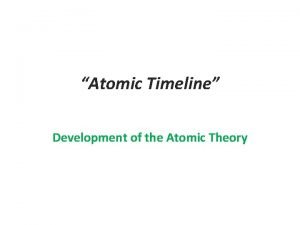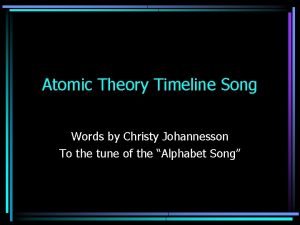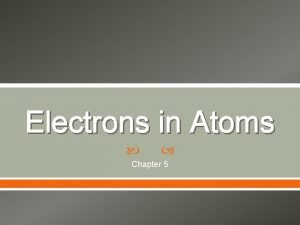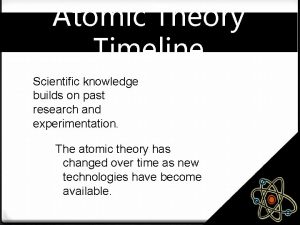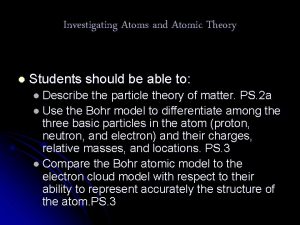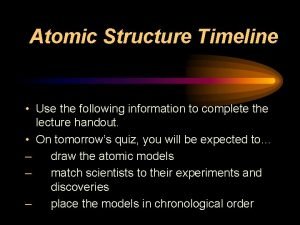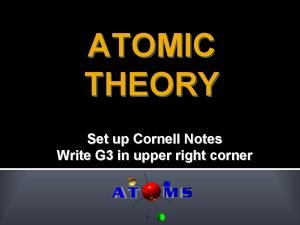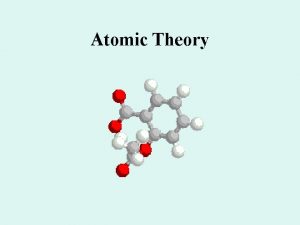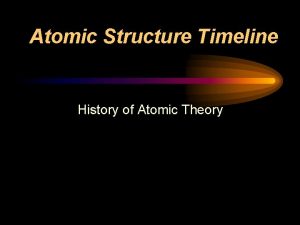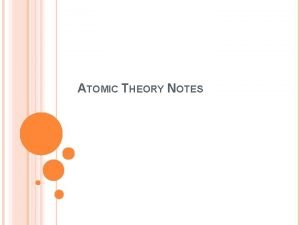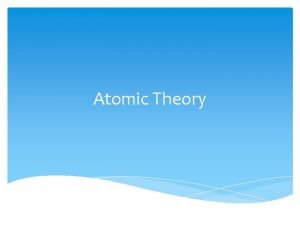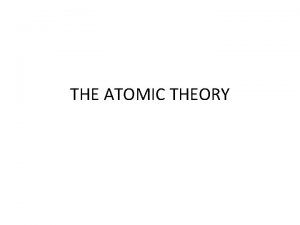Atomic Timeline Development of the Atomic Theory Democtritus











- Slides: 11

“Atomic Timeline” Development of the Atomic Theory

Democtritus • Greek • First coined the term “Atom” which means invisible and indivisible. • Came up with theory while trying to starve himself to death. • Aristotle had opposing theory which was believed for 2000 years

Boyle & Newton Robert Boyle • Began ‘experimental chemistry’ • Studied gases • Worked with Newton to bring alchemy out of the “dark ages”. Eventually became Chemistry. Isaac Newton • Isaac Newton was one of the first people to propose a “mechanical universe. ” He believed that the universe is made up of small solid masses that are constantly in motion. This idea is known as “The Mechanical Universe” idea. • Wrote article “Skeptycal Chemyst”

John Dalton • John Dalton formulated the Atomic Theory which states that: atoms of an element are different than atoms of other elements; atoms of one element are the same; that atoms of different elements can be combined; that atoms cannot be divided or separated; and that elements are made of tiny particles called atoms. • Used actual experimental work from Antoine Lavoisier (Law of conservation of Mass) and Joseph Proust (Law of Definite Proportions) to support his theory.

JJ Thomson • Experimented with Cathode rays. • Based on the work that he did, he discovered electrons, the first subatomic particle • He also developed a model of the atom called the “plum pudding” model. • Because of Thomson’s work, Dalton’s theory was adjusted.

Rutherford • Student of Thomson. • Designed gold Foil Experiment to prove Thomson’s model. • His experiment disproved Thomson and he proposed his own theory, the nuclear model of the atom.

Modern Atomic Structure • Scientists now know that there are three major subatomic particles: protons, neutrons and electrons. Particle proton neutron electron Location nucleus orbit nucleus (in the electron cloud) Mass 1 amu 1/2000 amu Charge + none -

How does this relate to the PTE? • You can use the periodic table of elements (PTE) to figure out how many protons, neutrons and electrons are in any atom on the table. Atomic mass (A) = p + n in the nucleus Atomic number (Z) = number of protons in the nucleus Au 197 79 Neutrons can be found by subtracting the atomic mass from the atomic number: N=A-Z

Atoms, Ions and Isotopes • The number of protons in an atom NEVER changes. This is how you identify an element. If the number of protons are changed, you have a whole new element. Atoms are electrically neutral (protons = electrons). • If an atom is heavier/lighter than expected (greater or lower atomic mass than on the PTE), neutrons have been added or lost. This is now an isotope. • If an atom becomes charged, it has lost (+) or gained (-) electrons. It is now an ion.

ELEMENT SYM A Z P N 13 79 14 17 197 7 240 88 48 18 80 2 17 3 83 92 74 58 38 24 19 E 130 36 25 20 51 54 ATOM, ION OR ISOTOPE

ELEMENT Aluminum Gold Cadmium Chlorine Mercury Lithium Bismuth Uranium Tungsten Cerium Strontium Chromium Potassium Antimony SYM A Z P N E Al 197 79 Au 114 48 Cd 36 -1 17 Cl 197 80 Hg 7 +1 3 Li 213 83 Bi 240 92 U 184 74 W 140 58 Ce 88 +2 38 Sr 49 24 Cr 39 19 K 122 -3 51 Sb 27 197 114 36 197 7 213 240 184 140 88 49 39 122 13 79 48 17 80 3 83 92 74 58 38 24 19 51 14 118 66 19 117 4 130 148 110 82 50 25 20 71 13 79 48 18 80 2 83 92 74 58 36 24 19 54 27 13 ATOM, ION OR ISOTOPE Atom Isotope Ion Isotope Atom ion
 Democtritus
Democtritus Democtritus
Democtritus Atomic theory timeline
Atomic theory timeline Models of the atom timeline
Models of the atom timeline Atomic theory timeline
Atomic theory timelineHenry moseley atomic theory timeline
 Atomic timeline
Atomic timeline Timeline of atomic structure
Timeline of atomic structure Atomic timeline
Atomic timeline Is atomic mass and relative atomic mass the same
Is atomic mass and relative atomic mass the same Periodic trends in properties of elements
Periodic trends in properties of elements Atomic radius in periodic table
Atomic radius in periodic table
